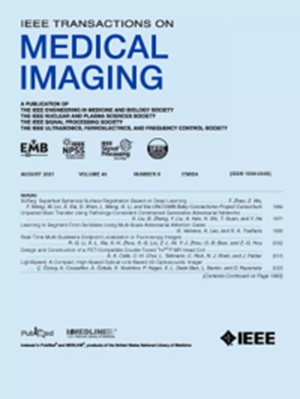基于部分标记数据集的深度互学习多器官分割。
IF 9.8
1区 医学
Q1 COMPUTER SCIENCE, INTERDISCIPLINARY APPLICATIONS
引用次数: 0
摘要
多器官标记用于分割是一个复杂且耗时的过程,导致全面标记的多器官数据集稀缺,而部分标记的数据集大量出现。目前的方法面临三个关键的局限性:对现有监督的不充分利用;推理复杂,泛化能力验证不足。本文提出了一种新的基于相互学习的多器官分割框架,通过部分标记数据集之间的信息互补来提高多器官分割的性能。具体来说,该方法由三个关键部分组成:(1)基于差异互学习的部分器官分割模型训练;(2)伪标签生成与过滤;(3)基于相似互学习的全器官分割模型训练。差分互学习使每个部分器官分割模型能够利用来自其他数据集的标签和特征作为互补信号,从而改进跨数据集器官检测以获得更好的伪标签。相似互学习为每个全器官分割模型训练增加了两个额外的监督来源:数据集间的真实情况和动态可靠的转移特征,显著提高了分割精度。该方法得到的模型对多器官分割具有较高的准确率和高效的推理能力。在头颈、胸部、腹部和骨盆的9个数据集上进行的大量实验表明,该方法达到了SOTA的性能。本文章由计算机程序翻译,如有差异,请以英文原文为准。
Deep Mutual Learning among Partially Labeled Datasets for Multi-Organ Segmentation.
Labeling multiple organs for segmentation is a complex and time-consuming process, resulting in a scarcity of comprehensively labeled multi-organ datasets while the emergence of numerous partially labeled datasets. Current methods face three critical limitations: incomplete exploitation of available supervision; complex inference, and insufficient validation of generalization capabilities. This paper proposes a new framework based on mutual learning, aiming to improve multi-organ segmentation performance by complementing information among partially labeled datasets. Specifically, this method consists of three key components: (1) partial-organ segmentation models training with Difference Mutual Learning, (2) pseudo-label generation and filtering, and (3) full-organ segmentation models training enhanced by Similarity Mutual Learning. Difference Mutual Learning enables each partial-organ segmentation model to utilize labels and features from other datasets as complementary signals, improving cross-dataset organ detection for better pseudo labels. Similarity Mutual Learning augments each full-organ segmentation model training with two additional supervision sources: inter-dataset ground truths and dynamic reliable transferred features, significantly boosting segmentation accuracy. The model obtained by this method achieves both high accuracy and efficient inference for multi-organ segmentation. Extensive experiments conducted on nine datasets spanning the head-neck, chest, abdomen, and pelvis demonstrate that the proposed method achieves SOTA performance.
求助全文
通过发布文献求助,成功后即可免费获取论文全文。
去求助
来源期刊

IEEE Transactions on Medical Imaging
医学-成像科学与照相技术
CiteScore
21.80
自引率
5.70%
发文量
637
审稿时长
5.6 months
期刊介绍:
The IEEE Transactions on Medical Imaging (T-MI) is a journal that welcomes the submission of manuscripts focusing on various aspects of medical imaging. The journal encourages the exploration of body structure, morphology, and function through different imaging techniques, including ultrasound, X-rays, magnetic resonance, radionuclides, microwaves, and optical methods. It also promotes contributions related to cell and molecular imaging, as well as all forms of microscopy.
T-MI publishes original research papers that cover a wide range of topics, including but not limited to novel acquisition techniques, medical image processing and analysis, visualization and performance, pattern recognition, machine learning, and other related methods. The journal particularly encourages highly technical studies that offer new perspectives. By emphasizing the unification of medicine, biology, and imaging, T-MI seeks to bridge the gap between instrumentation, hardware, software, mathematics, physics, biology, and medicine by introducing new analysis methods.
While the journal welcomes strong application papers that describe novel methods, it directs papers that focus solely on important applications using medically adopted or well-established methods without significant innovation in methodology to other journals. T-MI is indexed in Pubmed® and Medline®, which are products of the United States National Library of Medicine.
 求助内容:
求助内容: 应助结果提醒方式:
应助结果提醒方式:


